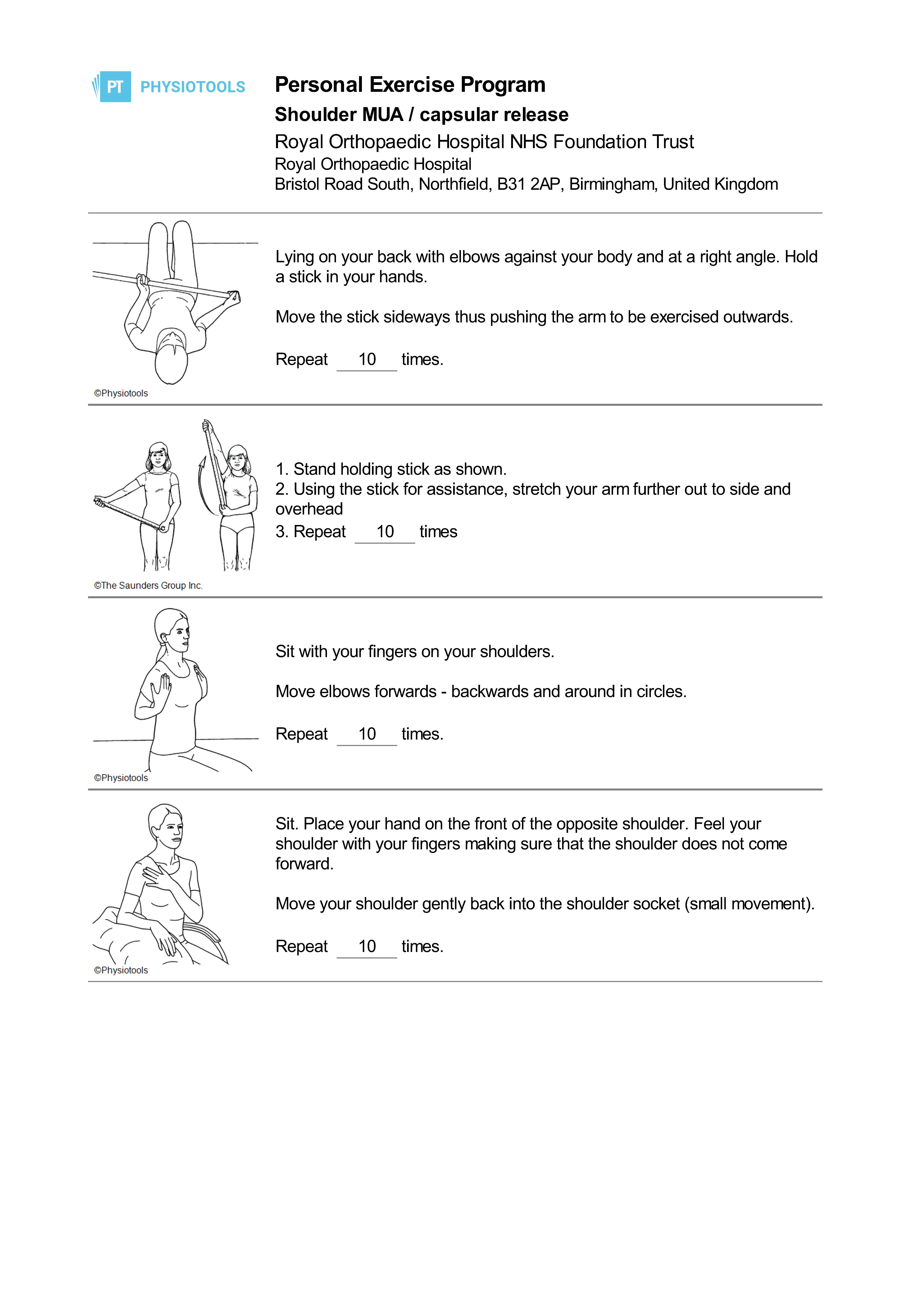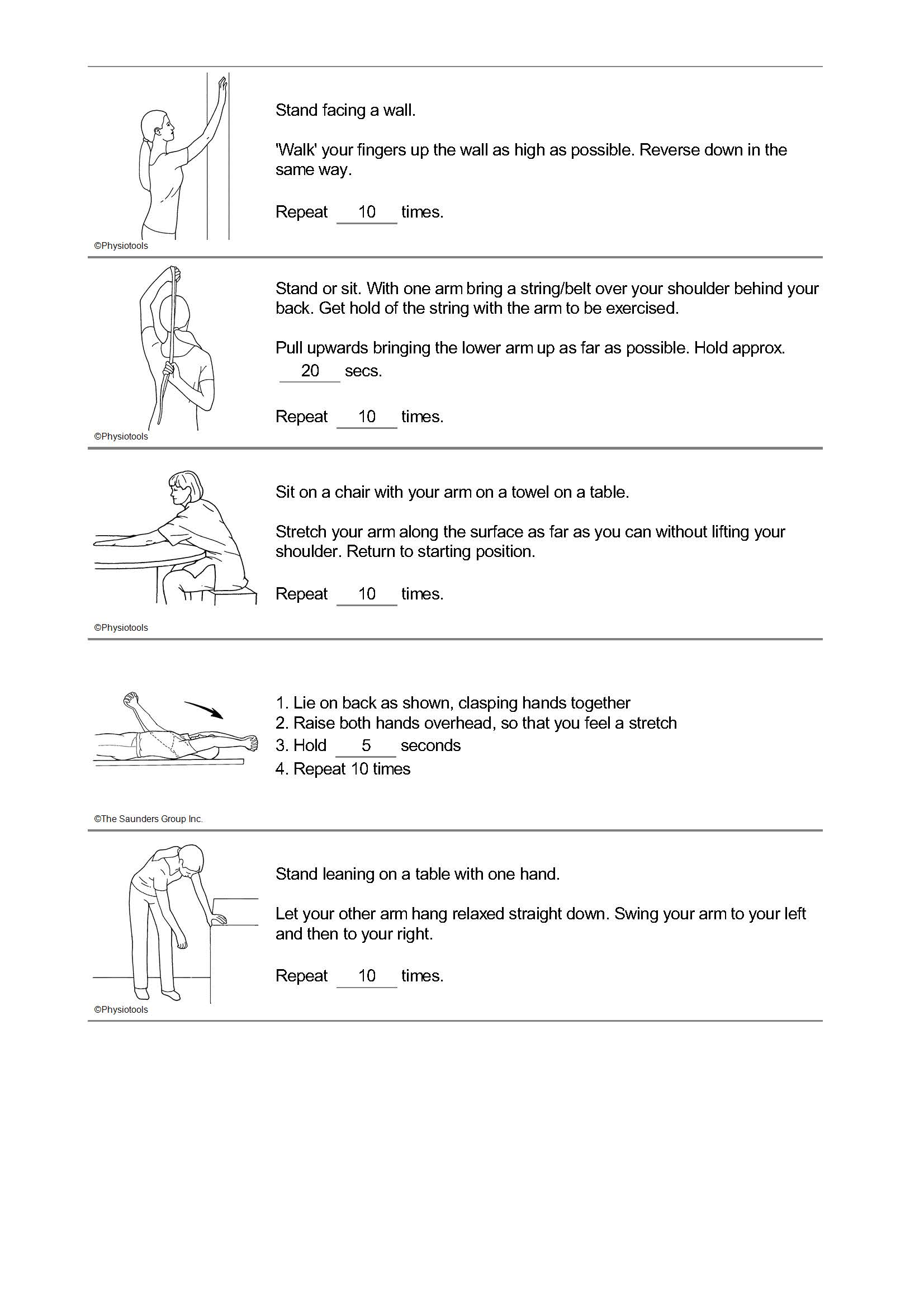
Shoulder Manipulation Under Anaesthetic and Arthroscopic Capsular Release
What is shoulder manipulation under anaesthetic and arthroscopic capsular release?
The aim of the manipulation under anaesthetic (MUA) operation is to try and increase the range of movement in your shoulder. The tight capsule will be torn by forceful but careful and controlled stretching of the arm while you are asleep. A capsular release is an operation performed using keyhole surgery or ‘arthroscopy’. In this case 2 to 4 small incisions (8-10mm) will be made around your shoulder in order for the arthroscope and the specialist releasing instruments to be passed into the joint. The scarring and tight capsule will be carefully released from the inside in order to improve your shoulder movements.
Why is it required?
Your shoulder has become inflamed and tight. Often this is due to a ‘frozen shoulder’. This process most commonly starts without an apparent cause but is more common in people suffering from diabetes. Sometimes, the pain and tightness follows a minor accident or injury. About 20% of people with a frozen shoulder get it again on the other side. Other people have a stiff shoulder following a major injury or after an operation. In this case the inflammation is often less of a problem but the tightness of the capsule due to scarring is preventing good movement.
What are the risks?
- There is a small risk of infection
- There is a small risk relating to general anaesthetic
- There is a very small risk that the upper arm may fracture when performing a MUA
What happens during surgery?
You will be escorted to theatre and will be taken to the anaesthetic room. Here, the surgeon and anaesthetist will greet you.
You will require a general anaesthetic for this procedure, if you have any questions regarding this you will have time to consult with your anaesthetist prior to your operation. A nerve block may be used before the operation, which means immediately following surgery your arm and shoulder will feel numb. This helps with pain but will wear off after 8-12 hours, so regular painkillers are advised and will be supplied by the hospital.
What happens after surgery
You will return from the operation wearing a sling; however, this is for comfort only whilst your arm is numb due the nerve block. Remember, this operation has been done to try and increase movement in your shoulder, so do not keep your arm in the sling for long periods without doing regular exercises. Discard the sling as soon as possible.
Your shoulder may be sore for a period of up to 6 weeks afterwards. It is advised that you continue taking your painkillers as prescribed during this time. The use of ice packs may also help by reducing the amount of inflammation in your shoulder, ice packs should be made from ice cubes in a plastic bag and wrapped in a damp tea-towel or pillowcase. Ice should never be directly applied to the skin as this can cause ice burns. Frozen peas or purpose made ice packs from the pharmacy are also ideal. The most effective duration of application of ice is 20-30 minutes every 2-3 hours. Ice should not be used if you have diabetes, Raynauds’s syndrome or in the presence of infection. Care should be taken if you have an existing heart condition. If you have, an existing heart condition, ice should not applied to the left shoulder.
If you have had an arthroscopy, you will have a dressing on your shoulder covering 2 to 4 keyhole wounds. Sutures are not always used and due to the amount of fluid passed through your shoulder during the operation, wounds may leak for 3 or 4 days. Wounds should be kept dry and your nurse will advise you regarding this.
Returning to work
This will depend on the type of work you do. If you have a desk-type job, you will probably be off work for a week. However, if you are involved in lifting or manual work you may not be able to do these for 2 weeks / 4-6 weeks after a capsular release. Please discuss any queries with the physiotherapist or hospital doctor.
When can I drive?
You will normally be able to resume driving within one to two weeks of the operation, check you can manage all the controls. It is also advisable to start with short journeys. You may find the seatbelt may be uncomfortable initially but your shoulder will not be harmed by it.
When can I participate in leisure activities?
Your ability to start these will be dependent on the range of movement and strength that you have in your shoulder following the operation. Nothing is forbidden. Please discuss activities that you are interested in with your physiotherapist or consultant. Start with short sessions frequently, involving little effort and gradually increases the intensity as your pain allows. You can try movements in water as soon as the wounds are healed. Doggy paddle or breaststroke may be easier initially. You can exercise the rest of the body immediately. Try to regain the natural swing of your arm as you walk.
When will my physiotherapy start?
You will need to start exercising immediately after your operation. You will require outpatient physiotherapy and this is usually done at the hospital nearest to where you live. This will be arranged through the hospital and you will receive a letter at your home address asking you to call and make a suitable appointment or a telephone call making an appointment for you. Commitment to your physiotherapy regime is crucial in order to get the best outcome from surgery. Should you fail to receive any contact regarding physiotherapy, feel free to contact us and we can look into this on your behalf.
Do I need to come back to clinic?
Yes. Your surgeon will request an outpatient appointment for you. This is usually at around 2-4 weeks although sometimes later. When you come to clinic you will be seen by a member of your consultant’s team. This may include senior registrars, clinical fellows, Postgraduate doctors or a nurse practitioner. Each will be happy to discuss with you any problems or further questions you have. Further appointments will be made after this as necessary.
Exercises
Use painkillers and/or ice packs to reduce the pain before you exercise. It is normal for you to feel aching, discomfort or stretching sensations when doing these exercises. However, if you experience intense and lasting pain (e.g more than 30 minutes) reduce the exercises by doing them less forcefully or less often. If this does not help, discuss the problem with the physiotherapist. Certain exercises may be changed or added for your particular shoulder. Do short frequent sessions (e.g. 5-10 minutes, 2 hourly) rather than one long session.Gradually increase the number of repetitions you do, the numbers stated here are rough guidelines.

